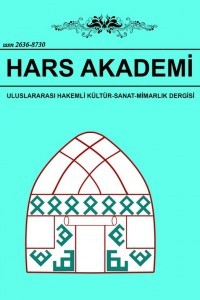BEDRİ RAHMİ EYÜBOĞLU’NUN “İSTANBUL DESTANI”
Bedri Rahmi Eyüboğlu eserlerinde destanları, masalları ve türküleri yeniden üreterek özgünlüğü yakalar. Gelenekten faydalanırken kendi sesini korur ve “Karadut”, “Türküler Dolusu”, “İstanbul Destanı”, “Yazma Destanı” gibi halk kültürünü yansıtan eserler verir. Bedri Rahmi Eyüboğlu şiirlerinde, geçmişi ve bugünü bir arada ele alırken eleştirel tavrını okura hissettirir. Masalların, türkülerin, destanların ve bilmecelerin edasını taşıyan şiirlerinde, acıları/ hazları söze dönüştüren, söze söz ekleyen şairin yaratıcılığını ortaya koyan, okura geçen duygu yoğunluğu ve ahenktir. Eyüboğlu, “İstanbul Destanı”nda İstanbul’un semtlerini ve hatırlattıklarını görsel, işitsel ve tatsal bakımdan destanlaştırır. Bedri Rahmi Eyüboğlu, halk şiirinin sesini geçmişten günümüze taşırken yapmacıklıktan uzak ve samimidir. “İstanbul Destanı”nda, İstanbul’un semtlerindeki hayatı ve kültürel özellikleri yansıtan destansı tasvirler Eyüboğlu’nun diğer eserlerindeki gibi yaşama coşkusuyla harmanlanır. İlhamını İstanbul’dan alan şair, destanlaştırdığı şehri yer yer büyülü yer yer eleştirel bir bakışla okura sunar.
Anahtar Kelimeler:
gelenek, halk şiiri, destan, folklor, İstanbul
BEDRI RAHMI EYUBOGLU’S “ISTANBUL EPIC”
Bedri Rahmi Eyuboglu, captures originality by reproducing epics, tales, and folk songs in his works. He protects his own voice while making use of the tradition and he produces works that reflect the folk culture such as “Black Mulberry”, “Full of Folk Songs”, “Istanbul Epic”, “Hand-painted Kerchief Epic”. Bedri Rahmi Eyuboglu makes feel his readers his critical attitude while handling the past and the present together in his poems. It is the intensity of emotion and harmony transmitted to the reader, which reveals the creativity of the poet who verbalizes the pain/pleasure into words and adds words to the poems in his poems, which have the tone of fairy tales, folk songs, epics and riddles. In “Istanbul Epic” Eyuboglu makes the districts of Istanbul and its reminders epic in terms of visual, auditory, and gustative. Bedri Rahmi Eyuboglu is far from being artificial but sincere while carrying the sound of folk poetry from the past to the present. In “Istanbul Epic” the epic description that reflects the life and the cultural features of Istanbul’s districts are blended with the joy of living as in Eyuboglu’s other works. The poet that inspired by Istanbul, presents the city that he makes epic to the reader with a sometimes magical sometimes critical point of view.
Keywords:
tradition, folk poetry, epic, folklore,
___
- Boratav, Pertev Naili (1969). 100 Soruda Türk Halk Edebiyatı. İstanbul: Gerçek Yayınevi.
- Boratav, Pertev Naili (1982). Folklor ve Edebiyat I. İstanbul: Adam Yayıncılık.
- Eliade, Mircea (2001). Mitlerin Özellikleri, (Çev. Sema Rifat). İstanbul: Om Yayınevi.
- Eyüboğlu, Bedri Rahmi (2006). Dol Karabakır Dol. İstanbul: Türkiye İş Bankası Kültür Yayınları.
- Koşar, Emel (2013). “Bedri Rahmi Eyüboğlu’nun ‘Yazma Destanı’”, Mühür, Sayı 46. Mayıs-Haziran. s. 122-124.
- Koşar, Emel (2013). Bedri Rahmi Eyüboğlu’nun Penceresinden Halk Kültürü. İstanbul: E Yayınları.
- Koşar, Emel (2016). “Bedri Rahmi Eyüboğlu’nun Şiir İşçiliği”, Bedri Rahmi Eyüboğlu 100 Yaşında Sempozyumu. İstanbul: MSGSÜ Yayınları. s. 104-108.
- Oğuz, M. Öcal (2004). “Destan Tanımı ve Eski Türk Destanları”. Millî Folklor, Sayı 62. s. 5-7.
- Orhan Veli (1982). Bütün Şiirleri, (Der. Asım Bezirci). İstanbul: Can Yayınları.
- Yahya Kemal (1974). Kendi Gök Kubbemiz. İstanbul: İstanbul Fetih Cemiyeti ve İstanbul Fetih Cemiyeti Yayınları.
- Yetiş, Kâzım (1994). “Destan”, İslâm Ansiklopedisi (DİA), (C. 9). İstanbul: Dergâh Yayınları. s. 202-205.
- Yayın Aralığı: Yılda 2 Sayı
- Başlangıç: 2018
- Yayıncı: Hatem TÜRK
Sayıdaki Diğer Makaleler
BİR TURİZM VE KÜLTÜREL MİRAS ALANI OLARAK HATİLA VADİSİ
BEDRİ RAHMİ EYÜBOĞLU’NUN “İSTANBUL DESTANI”
TÜRK KADIN HAREKETİNİN ÖNCÜ İSİMLERİNDEN NEZİHE MUHİDDİN -AÇIKLAMALI BİR KAYNAKÇA DENEMESİ-
TÜRK EDEBİYATINA MODERN BİR SOLUK: SERBEST MÜSTEZAD
DR. ÖĞR. ÜYESİ BAHADIR GÜLDEN İLE SON KİTABINDAN HAREKETLE BİR RÖPORTAJ
KİTAP TANITIMI VE DEĞERLENDİRME: DİJİTAL KÜLTÜR-2
SEDAT UMRAN VE MÜSTAKİL BİR ŞİİR KİTABI, AKŞAM ŞİİRLERİ
HATIRADA MÜDAFAA, MÜDAFAADA HATIRA: TALÂT PAŞA’NIN HATIRATI ÜZERİNE
ASYA ÜLKELERİ NEDEN DEMOKRATİKLEŞEMİYOR: BATI ÜLKELERİYLE BİR KARŞILAŞTIRMA
